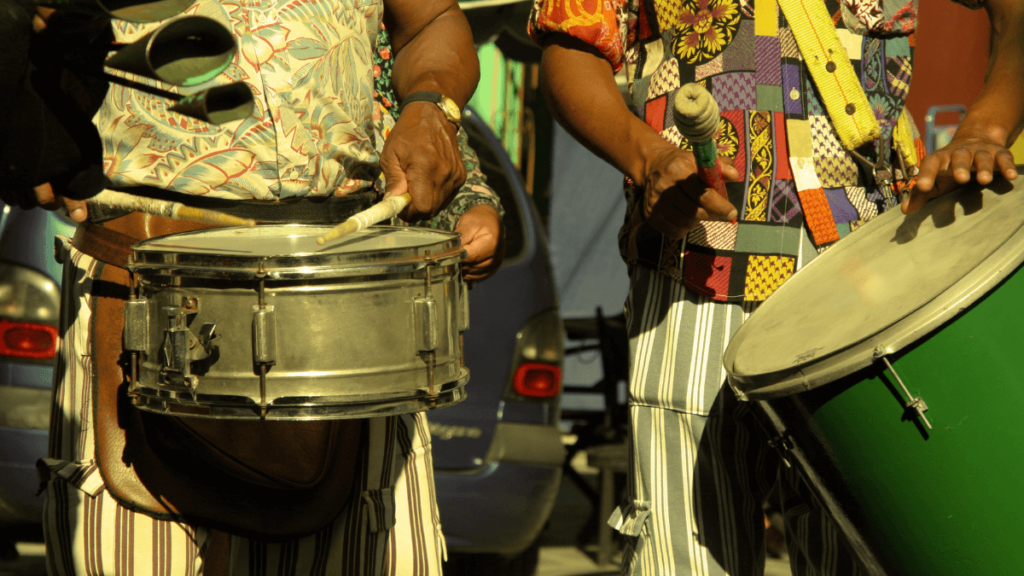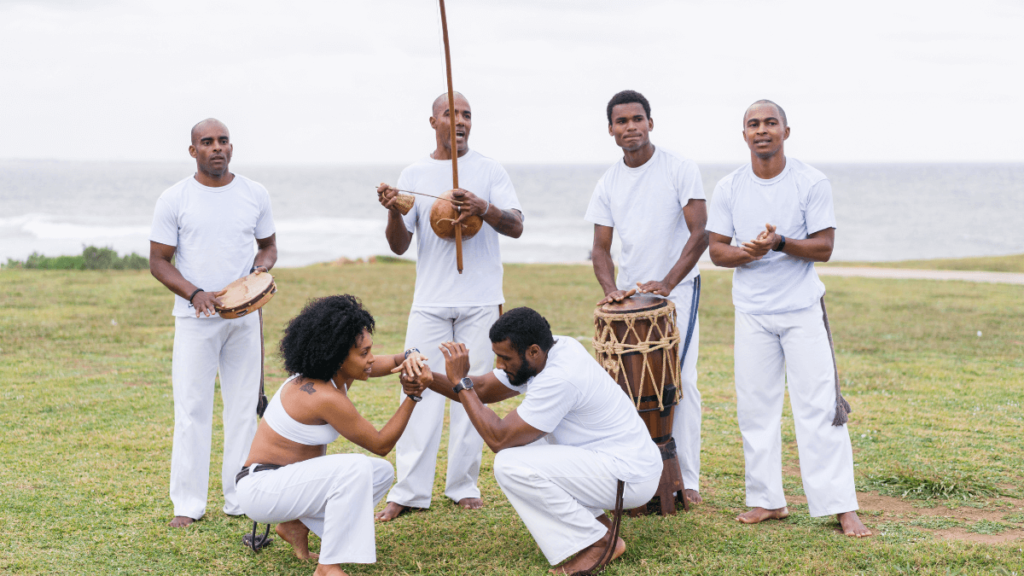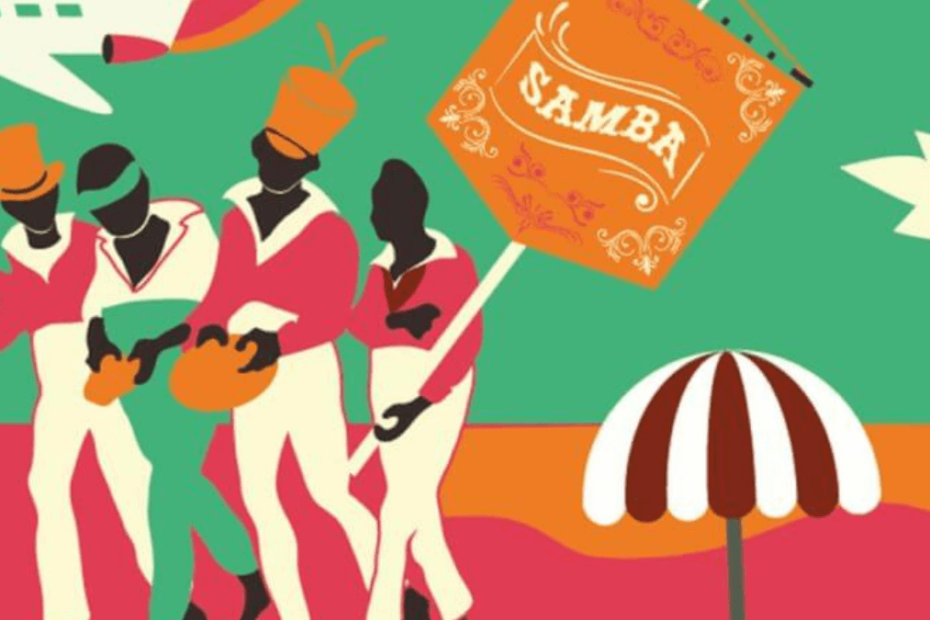- Samba is a rich cultural expression of Brazil, combining African rhythms, Portuguese melodies, and indigenous influences.
- It symbolizes Brazil’s mixed heritage and serves as a platform for cultural and social expression, especially for Afro-Brazilian communities.
- Samba has evolved into various forms, reflecting Brazilian society’s dynamic nature and global influence.
- It’s an integral part of Brazil’s national identity and cultural celebrations, particularly seen in its pivotal role in Brazilian Carnivals.
Olá, my friends from around the globe! Today, I’m here to take you on a rhythmic journey through the heart and soul of my beloved Brazil, where the beats of Samba pulsate through our streets, our carnivals, and our very identities.
When we talk about Samba, we’re not just talking about a dance form or a genre of music; we’re talking about a cultural phenomenon that has shaped and been shaped by the Brazilian way of life.
So, my friends, lace up your dancing shoes, let your hips loose, and prepare to immerse yourself in the multifaceted world of Samba – a world where every beat tells a story, and every step is a journey into the soul of Brazil. Vamos lá (let’s go)!
Meaning of Samba: is just a dance form or a genre of music?
Samba is a vibrant expression of Brazilian culture, born from a fusion of African rhythms with Portuguese melodies and indigenous influences. It symbolizes Brazil’s mixed heritage and serves as a platform for cultural expression.
Furthermore, Samba is:
- Symbol of Afro-Brazilian Identity: Samba has deep roots in Afro-Brazilian history and is closely linked to Candomblé and Capoeira. It reflects the heritage, struggles, and resilience of Afro-Brazilian communities.
- Form of Social and Political Resistance: Beyond its rhythmic and dance aspects, Samba has been used as a tool for social commentary and political resistance. It gives a voice to marginalized communities, reflecting their challenges and aspirations.
- A Reflection of Brazilian Society: Samba mirrors the dynamic nature of Brazilian society, reflecting its changes, challenges, and the diversity of its people. It is both a celebration of life and an artistic form of expressing the Brazilian spirit.
- Global Influence and Adaptability: Samba has transcended Brazilian borders, influencing global music and dance. It has adapted to different cultural contexts while retaining its core essence, demonstrating its universal appeal.
- Dynamic and Evolving Nature: Samba continues to evolve, embracing new forms and interpretations like Samba-reggae, while maintaining a balance between tradition and innovation. This adaptability ensures its relevance and resonance with new generations.
- Part of Brazil’s National Identity: Samba is deeply ingrained in Brazil’s national identity, symbolizing the country’s vibrancy, diversity, and spirit. It’s a living cultural artifact that continues to play a significant role in Brazilian society and beyond.

Plan your trip to Brazil
-
Find the cheapest flights
-
Discover the best accommodation
-
Explore this incredible country with the best experiences
-
Stay connected at all times with an eSIM
The Historical Roots of Samba
Samba’s story begins in the melting pot of cultures that is Brazil. Its roots stretch back to the African rhythms brought by the enslaved people, blending with indigenous Brazilian and European (especially Portuguese) influences.
This fusion gave birth to a rich variety of musical styles that gradually coalesced into what we now recognize as Samba.
In the late 19th and early 20th centuries, Samba began to take shape in the neighborhoods of Rio de Janeiro, especially in the favelas where Afro-Brazilian communities thrived.
It was a grassroots movement, a way for these communities to express their heritage, their struggles, and their joys.
The instruments, like the surdo (bass drum), tamborim (a small, hand-held drum), and the pandeiro (a type of tambourine), became the tools for this expression, and the Roda de Samba (Samba circle) became its stage.

Samba in the 20th Century: A Symbol of National Identity
As Samba evolved, it began to play a significant role in Brazil’s national identity. The 20th century, particularly the Vargas era (1930-1945), was crucial in this journey.
President Getúlio Vargas, recognizing the unifying potential of Samba, elevated it as a symbol of Brazil’s cultural and racial harmony.
Samba was no longer just a folk tradition of the Afro-Brazilian communities; it became a national treasure, promoted and even regulated by the government.
This period saw the birth of the Samba schools and the institutionalization of the Rio Carnival parade.
Samba schools, community-based organizations, became the heart of Brazil Carnival preparations, turning the dance and its music into a grand spectacle.
This transformation helped to spread Samba across the country, embedding it in the Brazilian consciousness.

Modern Transformations: Influence of Other Musical Genres and Global Spread
In recent decades, Samba has continued to evolve, influenced by other Brazilian music genres and the global music scene.
The emergence of Bossa Nova in the 1950s and 1960s, a more subdued and jazz-influenced style, brought a new dimension to Samba.
Later, Samba-Rock and Samba-Reggae emerged, blending Samba rhythms with rock and reggae elements, reflecting the dynamic and ever-changing nature of traditional Brazilian music.
One of the musicians who sums up all this function of samba in the 20th century is Jorge Ben, one of brazil’s leading singers:
On the global stage, Samba has made its mark too. It’s been embraced and celebrated worldwide, influencing music and dance far beyond Brazil’s borders.
One of the most famous songs by The Black Eywd Peas uses elements of a song by Jorge Ben:
Collaborations with international artists have introduced Samba to new audiences, while global events like the World Cup have showcased its energy and vibrancy to millions.
Samba’s historical journey is a testament to its resilience and adaptability.
From its humble beginnings in the Afro-Brazilian communities to its status as a symbol of national identity and its ongoing evolution in the global music scene, Samba remains a vital, living expression of Brazil’s cultural diversity and history.
Cultural Significance of Samba
Discover the deeper meaning of Samba, a rhythmic heartbeat of Brazil that transcends mere music and dance. It embodies a rich cultural tapestry, weaving together stories of heritage, resistance, and unity.
Join us as we explore how Samba resonates as a powerful symbol within Brazilian culture.
Samba and Afro-Brazilian Identity: Connection to Candomblé and Capoeira
Samba is more than a rhythm; it’s a vibrant thread in the tapestry of Afro-Brazilian identity. Its deep connection to Candomblé, an Afro-Brazilian religion, is profound.
The rhythms and dances of Samba are often seen as an extension of the ceremonial rhythms of Candomblé, creating a spiritual dimension that transcends mere entertainment.
It’s like each beat of the drum echoes the heartbeat of our ancestors, connecting us to a rich heritage that has survived and thrived against all odds.
Then there’s Brazilian Capoeira, the Afro-Brazilian martial art that combines elements of dance, acrobatics, and music. Just like Samba, Capoeira was a tool for cultural and physical survival among African slaves.

Both Samba and Capoeira symbolize resistance, resilience, and the joy of existence despite historical adversities.
When we dance Samba or engage in a Capoeira roda, we’re not just keeping our bodies fit; we’re honoring and preserving a legacy that’s integral to our Afro-Brazilian identity.
Samba as a Form of Resistance: Political and Social Dimensions
Samba has always had a rebellious soul. Beyond its infectious rhythms and exhilarating dances, it has been a potent form of social and political expression.
Throughout Brazilian history, Samba has given a voice to the voiceless, especially during times of political unrest and social inequality.
Its lyrics often reflect the struggles and aspirations of Brazil’s marginalized communities, offering commentary on issues like poverty, racial discrimination, and political corruption.
The transformative power of Samba is evident in how it has been used as a tool for resistance. During periods of government censorship and oppression, Samba became a subtle, yet powerful, way of speaking out against injustice.
The sambistas (Samba musicians and dancers) have historically used their art to challenge the status quo and inspire change, making Samba a rallying cry for those yearning for a better, more equitable Brazil.
Samba in Brazilian Carnivals: Role in Carnivals of Rio, Olinda, and Salvador
Carnival in Brazil is synonymous with Samba. In cities like Rio de Janeiro, Olinda, and Salvador, Carnival is when Samba truly comes alive in a spectacular explosion of color, music, and movement.
The Rio Carnival, with its world-famous Samba parade, is a dazzling display of creativity, skill, and passion.

Each Samba school tells a story through its elaborate floats, costumes, and choreography, turning the Sambadrome into a canvas where the vibrancy of Brazilian culture is painted in bold strokes.
In Olinda and Salvador, the Carnival experience is different but equally mesmerizing. The street carnivals here are pulsating, immersive celebrations where the boundary between performers and spectators blurs, and everyone becomes part of the rhythm.
The energy is electric, the atmosphere inclusive, and the sense of community, overwhelming.
The Dance of Samba: A Reflection of Society
Samba dancing is a physical language, telling stories through every sway, step, and spin. It’s an embodiment of our culture’s vibrancy and resilience.
The dance is characterized by quick, rhythmic steps with feet and hips moving in a lively, yet smooth manner. It’s like watching poetry in motion, where each movement tells a part of our collective story.
The footwork in Samba, often fast and intricate, symbolizes the complex path of our history – a dance of survival, joy, and resistance.
The hips move not just to the rhythm, but also to express the Brazilian spirit of sensuality and celebration of life. The arms, often outstretched or moving expressively, invite the world to join in our story, sharing in our joys and sorrows.
The dance’s pace can vary, reflecting the diversity of emotional and cultural narratives within Brazil.
Fast, energetic movements can represent the joy and exuberance of our Carnivals, while slower, more sensual motions might convey the depth of our emotions and the richness of our cultural tapestry. Each dancer brings their own interpretation, making Samba a personal, yet universal, language of expression.
Samba in the Sambadrome: A Showcase of Skill and Passion
The Sambadrome during Rio’s Carnival is where Samba takes center stage, showcasing the pinnacle of skill and passion.
It’s a place where the spirit of Samba is magnified, a spectacle that captures the essence of Brazilian enthusiasm and artistry.
Here, Samba schools from across Rio come together in a grand parade, each presenting a carefully choreographed performance that is a feast for the senses.
In the Sambadrome, Samba is more than just dance; it’s a high-energy, high-stakes competition where each school tells a story through its theme, music, costumes, and choreography.
The dancers, adorned in vibrant, often elaborate costumes, become living embodiments of their school’s narrative.
Their performances are a blend of artistry, athleticism, and sheer passion, reflecting not just their individual skills but also their deep connection to the community and the story they are telling.
Watching the Sambadrome performances, you’ll see the diversity of Samba expressed in its most elevated form.
The dancers’ movements, synchronized with the pounding rhythms of the bateria (drum section), create a powerful, emotive experience that stays with you long after the parade ends.

It’s a testament to the enduring power of Samba to bring people together, celebrate our shared heritage, and showcase the creativity and resilience of the Brazilian spirit.
The Global Influence of Samba
Samba’s influence has rhythmically sashayed far beyond the borders of Brazil, making a significant impact on the global music and dance scene.
Its infectious beat and lively energy have inspired artists and musicians around the world, leading to exciting collaborations and fusions.
A prime example of this is the collaboration between the legendary Brazilian musician Sergio Mendes and the international pop group Black-eyed Peas.
This fusion brought a contemporary twist to classic Samba rhythms, introducing this rich musical heritage to a whole new generation and demographic.
These collaborations are more than just a blend of musical styles; they represent a cultural exchange. Samba’s flexibility and adaptability make it a perfect partner for various musical genres, from pop and hip-hop to electronic and jazz.
This cross-pollination not only enriches the global music scene but also ensures that the essence of Samba continues to evolve and stay relevant in a rapidly changing world.
Samba Beyond Brazil: International Recognition and Adaptation
Samba’s journey onto the world stage has been nothing short of remarkable. From its roots in the Afro-Brazilian communities to its explosion in international popularity, Samba has gained recognition and admiration across the globe.
It’s not just the music that’s captivated audiences worldwide; the dance itself, with its vibrant energy and expressive movements, has become a staple in dance schools and cultural festivals far from Brazil.
Internationally, Samba has adapted to different cultural contexts while retaining its core spirit.
In countries like Japan, the United States, and many in Europe, Samba schools and parades have become part of the local cultural landscape, celebrating not only Brazilian culture but also the universal language of music and dance.
These adaptations often blend local dance styles with traditional Samba, creating unique interpretations that respect the dance’s roots while reflecting the diversity of its global audience.
The global spread of Samba is a testament to its universal appeal. It speaks to the human desire for rhythm, joy, and connection, transcending language and cultural barriers.
As Samba continues to inspire and be embraced by people around the world, it serves as a vibrant ambassador of Brazilian culture, spreading the message of unity, celebration, and the indomitable spirit of joy.
The Future of Samba in the 21st Century
As we step into the future, Samba continues to dance to the beat of change, embracing new meanings and forms.
One of the most exciting developments in recent years is the emergence of Samba-reggae, a musical genre that originated in Bahia, the Afro-Brazilian heartland.
This fusion combines the traditional rhythms of Samba with the more laid-back, reggae beats, symbolizing a cultural dialogue between Brazil and the Caribbean. It’s a vibrant example of how Samba is evolving, absorbing new influences while retaining its soul.
But Samba-reggae is just the tip of the iceberg. Across Brazil and beyond, musicians and dancers are experimenting with Samba, blending it with everything from electronic music to rock, creating fresh interpretations that appeal to a diverse, modern audience.
These new forms of Samba are not just about music and dance; they’re about storytelling, identity, and cultural expression. They reflect the dynamic nature of our society and the ongoing conversation between tradition and modernity.
Conclusion: Samba as a Living Cultural Artifact
As we come to the end of our rhythmic journey, it’s clear that Samba is not just a dance or a musical genre. It’s a living cultural artifact, a heartbeat of Brazil that resonates across the world.
Samba embodies the joy, resilience, and spirit of a nation that has faced historical challenges yet continues to dance with hope and vibrancy.
Samba’s enduring significance in Brazil and worldwide is a testament to its powerful appeal and adaptability.
It has become a global phenomenon, transcending cultural and linguistic barriers, while remaining deeply rooted in Brazilian soil.
Samba reflects the soul of Brazil, telling stories of its past, present, and future, and connecting people through its universal language of rhythm and movement.
The dynamic nature of Samba, its ability to evolve while maintaining its essence, is what makes it an integral part of Brazil’s cultural identity.
It’s a dance that captures the complexity of Brazilian society, a society that is continuously evolving, yet firmly anchored in its rich cultural heritage.
Samba has absorbed influences from around the world, yet it never loses its core identity, much like Brazil itself.
In essence, Samba is more than just a cultural expression; it’s a symbol of life, a celebration of diversity, and a unifying force that brings people together in joy and solidarity.
Here’s another song that represents much of what samba is for us Brazilians, one of the lyrics says:
“I am Samba
I’m from Rio de Janeiro
I’m the one who brings joy
To millions of Brazilian hearts”:
So, let’s keep dancing to the rhythm of Samba, embracing its energy and letting it guide us through the complexities and beauties of life. The dance goes on, and so does the story of Samba, an ever-evolving, never-ending tale of rhythm, resilience, and joy. Viva o Samba!
Did you like our content, do you want to get to know our country?! Discover the best experiences to live in Brazil!




